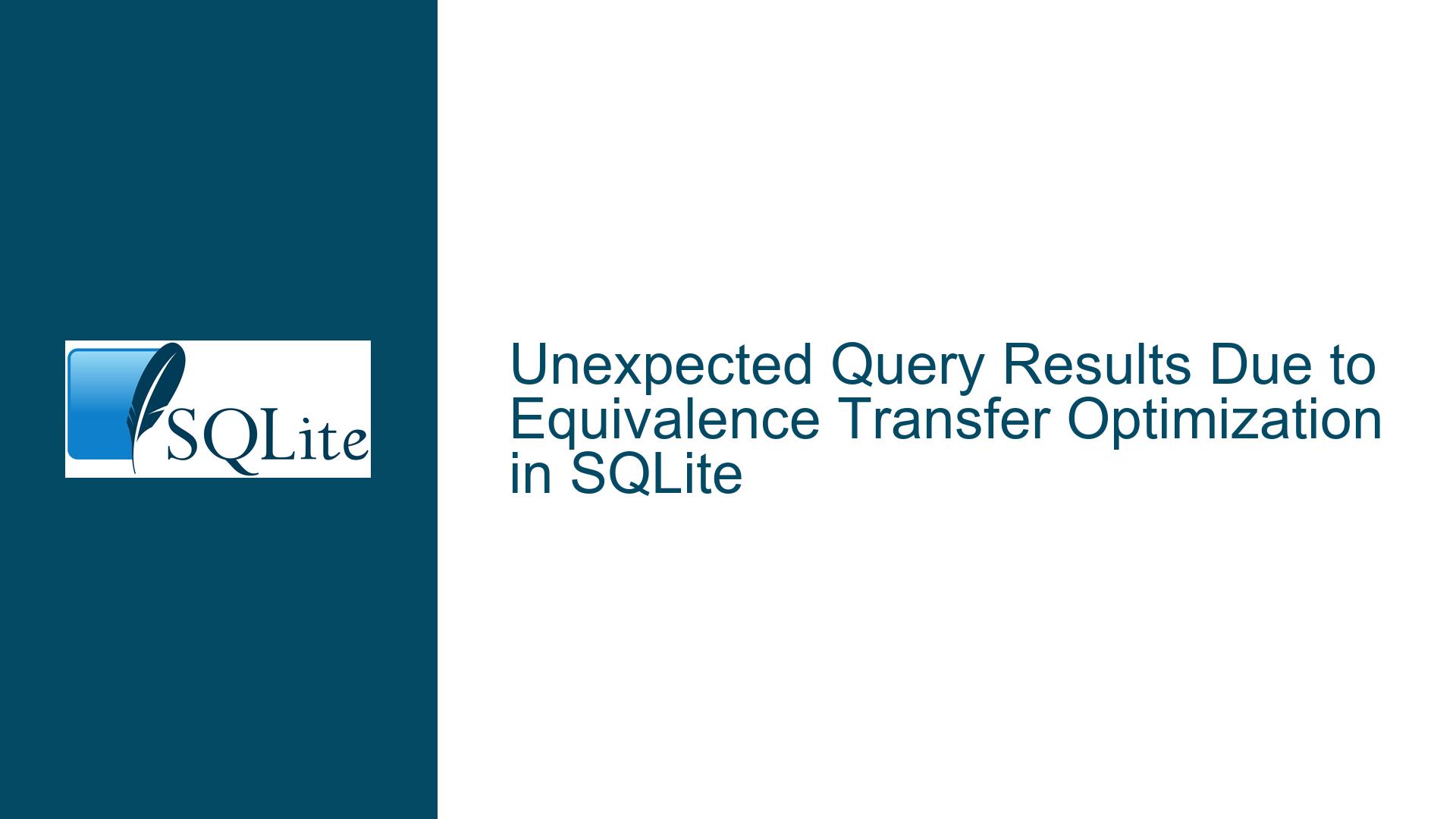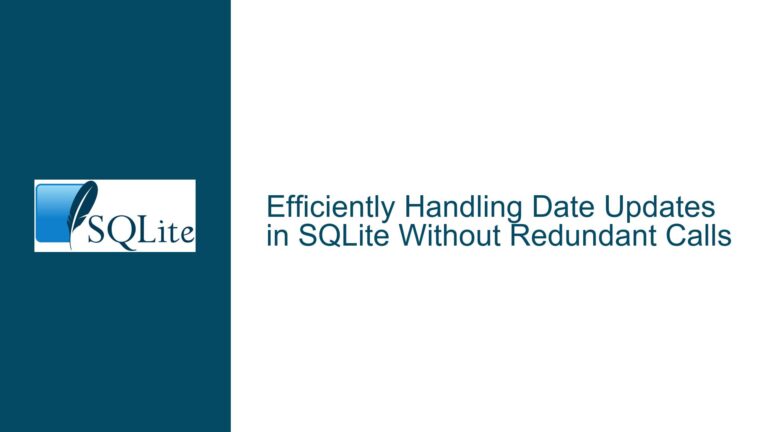Unexpected Query Results Due to Equivalence Transfer Optimization in SQLite
Issue Overview: Unexpected Query Results with Equivalence Transfer Optimization
The core issue revolves around a discrepancy in query results when using equivalence transfer optimization in SQLite, particularly when dealing with INTEGER PRIMARY KEY columns. The problem manifests when executing a query that involves joining two tables, t1 and t2, where the join condition includes both an equality check and a primary key comparison. The query is expected to return an empty result set, but instead, it returns unexpected rows due to an oversight in the equivalence transfer optimization logic.
The schema in question involves two tables:
t1(a INT PRIMARY KEY): A table with a single columnadefined as an integer primary key.t2(x INTEGER PRIMARY KEY, y INT): A table with two columns,xdefined as anINTEGER PRIMARY KEYandyas an integer.
The issue arises when executing the following queries:
SELECT * FROM t2, t1 WHERE t2.y = t1.a AND t1.a = t2.x; -- Expected: empty result
SELECT * FROM t2, t1 WHERE likely(t2.y = t1.a) AND unlikely(t1.a = t2.x); -- Unexpected: two rows returned
The first query correctly returns an empty result set, as there are no rows in t2 where y matches a in t1 and a matches x in t2. However, the second query, which uses the likely() and unlikely() functions to influence the query planner’s behavior, incorrectly returns two rows. This unexpected behavior is attributed to the equivalence transfer optimization, which failed to account for the INTEGER PRIMARY KEY constraint when transferring equivalence classes.
Possible Causes: Equivalence Transfer Optimization and INTEGER PRIMARY KEY Handling
The root cause of this issue lies in the way SQLite’s query planner handles equivalence transfer optimization, particularly when dealing with INTEGER PRIMARY KEY columns. Equivalence transfer optimization is a technique used by SQLite to simplify query conditions by recognizing that certain columns are equivalent due to equality constraints. This optimization can significantly improve query performance by reducing the number of comparisons needed during query execution.
However, in this case, the optimization logic did not properly consider the implications of INTEGER PRIMARY KEY columns. Specifically, the query planner failed to recognize that the INTEGER PRIMARY KEY column x in t2 is inherently unique and should not be treated as equivalent to other columns unless explicitly proven otherwise. This oversight led to the query planner incorrectly transferring equivalence classes, resulting in the unexpected query results.
The likely() and unlikely() functions further exacerbated the issue by influencing the query planner’s decision-making process. These functions are used to provide hints to the query planner about the expected likelihood of a condition being true or false. In this case, the use of likely(t2.y = t1.a) and unlikely(t1.a = t2.x) caused the query planner to prioritize the t2.y = t1.a condition over the t1.a = t2.x condition, leading to incorrect equivalence transfer and, consequently, incorrect query results.
Troubleshooting Steps, Solutions & Fixes: Addressing Equivalence Transfer Optimization Issues
To address this issue, it is essential to understand the underlying mechanics of equivalence transfer optimization and how it interacts with INTEGER PRIMARY KEY columns. The following steps outline the process of identifying, troubleshooting, and resolving the issue:
Understanding Equivalence Transfer Optimization: Equivalence transfer optimization is a powerful feature in SQLite that allows the query planner to simplify complex query conditions by recognizing that certain columns are equivalent due to equality constraints. This optimization can significantly improve query performance by reducing the number of comparisons needed during query execution. However, it is crucial to ensure that the optimization logic correctly handles all types of columns, including
INTEGER PRIMARY KEYcolumns.Identifying the Issue: The issue was identified through a test case that demonstrated unexpected query results when using equivalence transfer optimization with
INTEGER PRIMARY KEYcolumns. The test case involved joining two tables,t1andt2, with a join condition that included both an equality check and a primary key comparison. The query was expected to return an empty result set, but instead, it returned unexpected rows due to incorrect equivalence transfer.Analyzing the Query Planner’s Behavior: To diagnose the issue, it is necessary to analyze the query planner’s behavior when executing the problematic query. This can be done using the
EXPLAIN QUERY PLANstatement, which provides detailed information about how SQLite plans to execute a query. By examining the query plan, it is possible to identify where the equivalence transfer optimization is being applied incorrectly.Reviewing the Equivalence Transfer Logic: The next step is to review the equivalence transfer logic in SQLite’s query planner, particularly how it handles
INTEGER PRIMARY KEYcolumns. The logic should be updated to ensure thatINTEGER PRIMARY KEYcolumns are treated as unique and not equivalent to other columns unless explicitly proven otherwise. This may involve modifying the code that performs equivalence transfer to account for the unique nature ofINTEGER PRIMARY KEYcolumns.Testing the Fix: Once the equivalence transfer logic has been updated, it is essential to test the fix to ensure that it resolves the issue without introducing new problems. This can be done by running the original test case and verifying that the query now returns the expected result. Additionally, it is important to test other queries that involve
INTEGER PRIMARY KEYcolumns to ensure that the fix does not have unintended side effects.Deploying the Fix: After the fix has been thoroughly tested, it can be deployed to production environments. This may involve updating the SQLite library or applying a patch to the existing installation. It is important to communicate the fix to users and provide guidance on how to update their installations to ensure that the issue is resolved for all affected systems.
Monitoring for Regressions: Finally, it is crucial to monitor for any regressions or new issues that may arise as a result of the fix. This can be done by running automated tests, monitoring query performance, and gathering feedback from users. If any new issues are identified, they should be addressed promptly to ensure the stability and reliability of the SQLite database.
In conclusion, the issue of unexpected query results due to equivalence transfer optimization in SQLite is a complex problem that requires a deep understanding of the query planner’s behavior and the underlying mechanics of equivalence transfer. By following the steps outlined above, it is possible to identify, troubleshoot, and resolve the issue, ensuring that SQLite continues to provide reliable and efficient query execution for all users.






